Animals That Were Scarier Than Dinosaurs
Although history has been kind to dinosaurs, there were plenty of animals that were scarier than dinosaurs, starting from the depths of the seas to the skies. Just imagine this scene.
An 8.8-inch tall male terror bird is pacing carefully in his territory. But he’s not alone. A Smilodon is watching from the shadows, his saber-like teeth ready to land a fatal blow.
A few miles away, a 3,500-pound short-faced bear is waiting for a winner between the two….
In the meantime, deep down in the abyss of the oceans, an almost biblical sea monster with the longest teeth of any known creature on Earth is casually eating a baleen whale for breakfast.
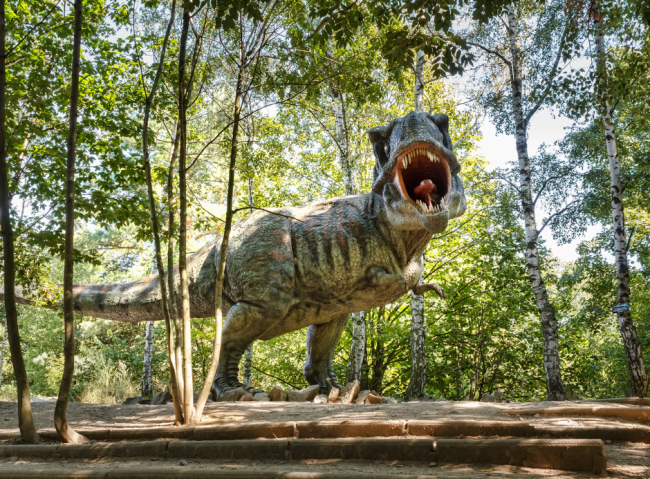
16 animals that were scarier than dinosaurs
Life million years ago was cruel, violent and unpredictable, almost like Mother Nature was experimenting with huge apex predators with weird spiral teeth, unique body movements, and ferocious behaviors.
But then, the experiments stopped, when a new contender for the title of apex predator emerged – not with fearsome claws or teeth, but with cunning strategy and deadly efficiency.
Join us as we look at the scariest apex predators our planet has ever known, from a 4-ton marine giant to a 42-feet long snake battling it out with a dinosaur. Their stories are fascinating, their existence puzzling, their anatomy mind-blowing, but can you guess who wins in the end?
1. Dunkleosteus
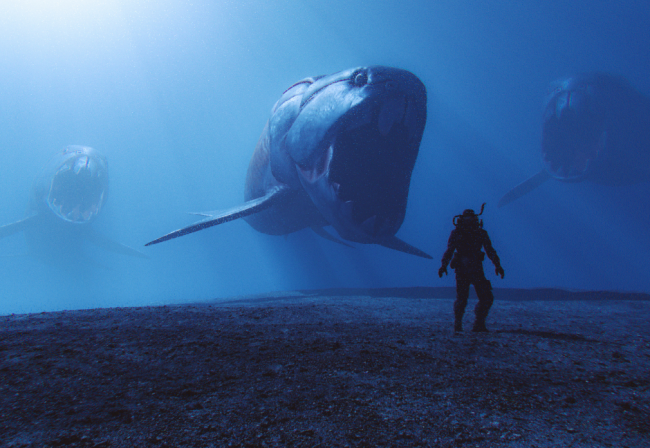
Imagine you’re casually scuba diving when suddenly, a 33-foot-long monster starts circling you. It weighs almost 4 tons, and has a body like steel as jointed plates of armor cover its head and chest.
It doesn’t have real teeth, but those sharp protrusions on his mouth don’t look too friendly. They appear as two long, bone-like blades capable of snapping and smashing virtually anything. What’s even worse is that the shape of the jaw is such that the two cutting edges sharpen against each other when clamped together. Not a bad design, but outright terrifying.
Nevertheless, rest assured, this monstrous predator of the oceans lived during the Devonian period, about 370 to 360 million years ago. That’s about 100 million years before the dinosaurs walked the Earth, and he’s obviously extinct today.
Its name is Dunkleosteus, and he had a deadly powerful bite of 11,000 pounds, with the tip of its bony fang generating 80,000 pounds per square inch. By comparison, a lion’s bite is about 650 pounds/square inch.
What’s even more astonishing is that the Dunkleosteus could open its mouth in merely one fiftieth of a second, generating a powerful suction force that would pull fast prey directly into its mouth. Scientists consider the Dunkleosteus as one of the first true apex predators ever seen in the vertebrate world.
Actually, the Dunkleosteus was quite greedy, and scientists believe it would often suffer from indigestion. Regurgitated and partially digested fish remains were often found in close proximity to the fossils of this prehistoric monster.
2. Arctotherium
Now let’s get you out of the seas and back to the forest. You’re having a nice, refreshing hike when you come face to face with a bear almost 3 times the size of the average grizzly. Standing on its hind legs, it towers over you, reaching an imposing height of 14 feet, with arms 3 times the size of yours. It’s looking at you with what first appears to be a cute, cuddly face, but the 3,500-pound beast is no teddy bear you can play with. It’s actually the Arctotherium angustidens, the largest bear ever to walk the Earth..
Lucky for you, this huge, ferocious bear with a short snout, rounded ears and cheek teeth lived between 2 million and 500,000 years ago, with its closest living relative now being the spectacled bear of South America. Arctotherium angustidens is just one of the five main species under the Arctotherium genus.
They consumed both meat and plants and lived solitary outside of the breeding season, much like the modern bears. Following a gestation period estimated to be between six and nine months, mothers would typically give birth to just a few cubs at a time. The broken teeth fossils discovered led scientists to believe that the Arctotherium used to chew on a lot of bones. He was probably more of a scavenger than an active hunter, using its big size and ferocity to scare away other apex predators and steal their prey.
3. Helicoprion
A fossilized spiral of teeth posed a total mystery for scientists ever since its discovery in 1950. Teeth usually come in the form of rows within the mouth, arranged in a manner that allows the animal to tear, crush and chew on their food. So, what manner of monster would have clusters of teeth arranged in a spiral at the center of their lower jaw? It’s called a Helicoprion, and it lived about 290 million years ago, at a time when sharks were only starting to emerge on the undersea food chain.
The Helicoprion survived what is known as the Permian-Triassic Extinction Event, which killed 95% of all marine animals. But let’s get back to its weird spiral of teeth, shall we? Because they are still fascinating scientists today. As far as paleontologists can tell, these bizarre rotating teeth functioned much like a circular saw blade. They kept growing outwards, while the whole construction spiraled inwards, never shedding the old teeth, but instead adding more to it. At the beginning the teeth were small and they gradually increased in size.
Some experts believe the Helicoprion was using its whorl of teeth to grind away the shells of swallowed squid and other soft-bodied prey by pulling them into its mouth in a circular, saw-like motion. Others, probably binging too much Stranger Things, believe it snapped its coil of teeth like a whip, zapping any unfortunate creators in its path.
No matter which theory you choose, this spiraled enigma of the Helicoprion is solid proof that Mother Nature can be a weirdo.
4. Sarcosuchus
This bad boy of the Cretaceous period was big enough to put dinosaurs on the menu if it wanted to. The Sarcosuchus was 40 feet long and weighed about 10 tons. That means twice the size of the biggest saltwater crocodile you’ve seen at the zoo, although, technically, it wasn’t really a crocodile. It was actually the great great grandfather of the crocodiles as we know them today.
Scientists have found out that it used to roam the swamps of what is now Africa and South America. This region, teeming with life, was the perfect home for a wide variety of giant reptiles and dinos.
It could move between land and water just as fast. Its 6-foot long skull contained 132 teeth, all ready to chew on any dino nuggets it could find.
Although it’s not confirmed that Sarcosuchus actively hunted dinosaurs, it wouldn’t have needed to back down from a scrap with one. It could have even managed to potentially snap the neck of a sizable theropod like Spinosaurus—the largest carnivorous dino on record. Imagine that battle!
Scarier than dinosaurs? Yes
The name Sarcosuchus translates to “flesh crocodile” from Greek, but that wasn’t snazzy enough for National Geographic. In 2001, they changed it to “SuperCroc” for their documentary and that stuck with the popular culture playbook.
And if all these weren’t enough, wait ‘till you hear of the Sarcosuchus’s bulla. Positioned at the end of its long, narrow snout, it served as a sexually selected trait. It was like, male Sarcosuchus with the largest bulla were more attractive to potential mates during the breeding season. Moreover, scientists claim that the bulla could have enhanced the creature’s sense of smell, serve as a combat practical tool or even as a communication device, emitting sounds across the big rivers and swamps of that dark era.
5. Mosasaurus
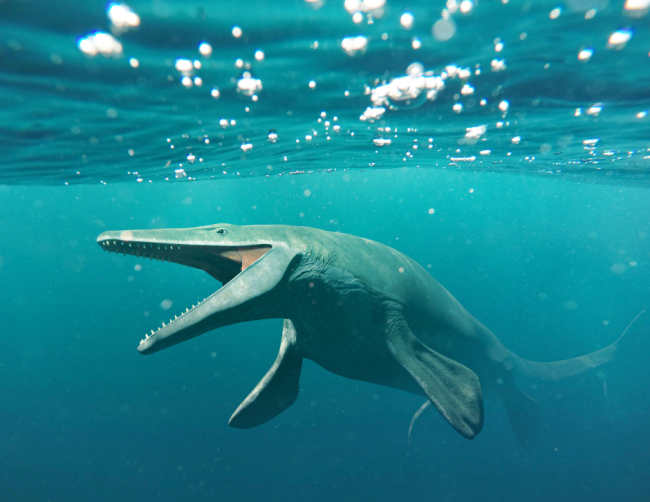
The great T-Rex of the seas, the Mosasaurus, was one formidable marine creature that claimed the oceans of the Cretaceous period as its own kingdom.
Despite its aquatic habitat, it was actually breathing air, similar to modern reptiles. It spread into a diverse array of subfamilies and species that then took over the globe, reaching as far as Antarctica. Some of its relatives loved crushing shells, others ventured into freshwater environments.
Although each species had its unique features, most Mosasaurs shared a long, snake-like body. They had arms and legs like flippers and double-hinged jaws that could open wide to swallow prey whole.
Their teeth were conical, helping grasp and grip at any slippery prey that would try to get away. But they also had a second row of spare teeth on their upper jaw. It helped them hold on to the prey why it was being swallowed.
The Mosasaurus was also a very efficient swimming machine. By studying a well-preserved fossil mosasaur and remaking its muscle fiber bundles in 3D, scientists have concluded that this outstanding creator would hold the front of its body rigid while using the rear and tail for propulsion.
As for looks, the Mosasaurus was darker in color, much like a Sperm Whale, blending mysteriously into the deep waters. How could we possibly know this? Because of something called fossilized melanosomes, which are essentially color-bearing intracellular organelles that can be preserved with certain fossils. How cool is that?
6. Megalodon
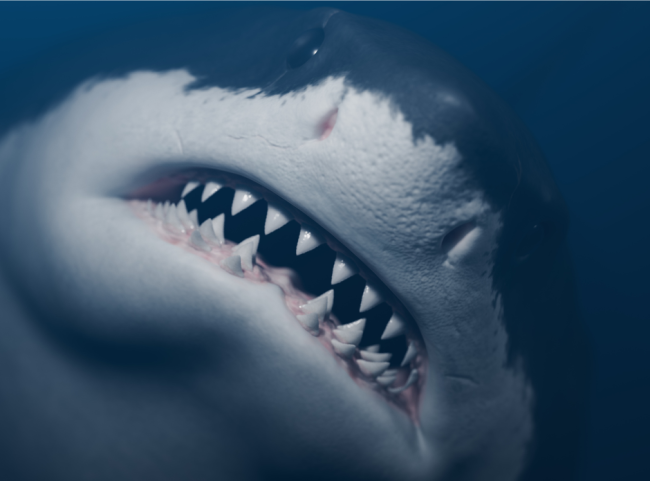
“There’s a monster outside, and it’s watching us”.
For all of those who haven’t seen the movie, yes, that’s Meg, a 60-feet long shark which went extinct some 2.8 million years ago. That means it ate many of the animals that still exist today, like sea turtles and whales! For context, the largest shark today is just about 20 feet. The Megalodon would eat the shark from Jaws for breakfast.
Otodus megalodon, which means “big tooth” , had some ferocious jaws with teeth up to seven inches long that would cut through any whale’s thick skin.
The Megalodons would also grow at an insane rate, which helped them become larger and larger over time, with the average weight at around 70 tons, but some could go as high as 103 tons.
Even more, scientists believe that the Megalodon was a killer from the womb, with Otodus embryos eating their weaker smaller womb-mates. That’s a big boy right there.
7. Livyatan melvillei
“Call me Ishmael” and watch out for the Livyatan melvillei, an extinct whale that was named both for the biblical sea monster Leviathan and also for Herman Melville, the author of the masterpiece Moby Dick.
It was really not Captain Ahab’s obsession because the Livyatan melvillei lived about 12 to 13 million years ago, during the Miocene Period, but it could have been.
It was about 44 to 57 feet long, with a monstrous 10-feet skull, and probably the longest teeth of any known creature, extinct or alive. Unlike the sperm whale which lacks upper teeth, the Livyatan melvillei boasted massive 5-inches wide and deeply rooted upper teeth and a somewhat shorter, broader snout.
On top of its skull, you could find a sac filled with fluid, also known as the spermaceti organ. Much like on the sperm whales of today, scientists don’t know for sure what it is used for. The main theory is that it could help control the buoyancy of the whale. The temperature of the spermaceti oil could change to a cooler temperature, increasing the density and helping the whale dive even deeper into the ocean. Conversely, it could also warm up, helping the whale rise to the surface. Moreover, the spermaceti organ could also play a crucial role in echolocation, functioning as a biological sonar to navigate and locate prey deep into the ocean.
A whale scarier than dinosaurs? Well, yes!
Historically, the spermaceti organ was of high value to humans hunting the sperm whales in the 18th and 19th centuries. The oil inside this sac would be used in oil lamps, candles, lubricants as it could burn brightly and clearly.
Lucky for us, the modern sperm whales were no Livyatan melvillei. Because if they were, humans wouldn’t have stood a chance. I mean, the Livyatan would prey upon baleen whales and other large marine mammals. Its mouth was approximately 6 feet long and 4 feet wide – three times the size of the mouth of the killer whale, and large enough to fit a grown person or, say, the whole head of a Tyrannosaurus rex! Quite the impressive predator of the ancient seas, wouldn’t you say?
8. Titanoboa
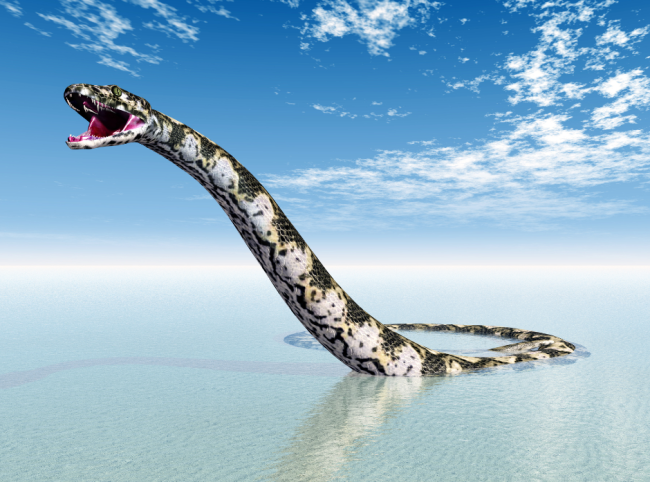
Are you afraid of snakes? Imagine you come face to face with one that’s 42 feet long, and weighs about 1.1 tons or 2,425 pounds. It lurks at the water’s edge, ready to launch a surprise attack on anyone who would dare come near.
Lucky for you, what we are describing now is Titanoboa, a huge snake that lived in the rain forests of South America some 58 million years ago, during the Paleocene period, less than ten million years after the asteroid impact wiped out the non-avian dinosaurs.
To put it more into perspective, the green anaconda, which is the largest snake living today, reaches a maximum weight of around 550 pounds and stretches just over 16.5 feet in length.
So, as the name suggests, the Titanoboa was indeed a “titanic boa” which made its mark in an era when the Earth was recovering from the catastrophic asteroid impacts. This is when mammals started to diversify and grow larger, but reptiles like Titanoboa were also growing in size.
9. Argentavis Magnificens, the giant condor
As tall as a human, with a wingspan rivaling that of a small airplane, the Argentavis Magnificens was bossing the skies 6 million years ago, during the late Miocene period.
Don’t be fooled into thinking it’s just a bird, because it was much more than that. It was a true apex predator without real natural enemies. It could spot its prey from high above, then swoop down, grasp it by the neck and swallow it whole, often without needing to touch land.
This magnificent prehistoric giant bird had an eagle-like beak lined up with sharp, tooth-like spikes that allowed the creature to seize and consume large quantities of meat. Scientists believe the Argentavis Magnificens ate around 5 to 10 pounds of meat per day, including rodents, armadillos, small sloths, rabbits or carcasses of dead mammals.
Thanks to its massive 26-feet long wingspan, the Argentavis Magnificens spent most of its time gliding in the air, soaring at high altitudes with minimal flapping. Despite its staggering height of up to 6.5 feet, Argentavis was not overly heavy, weighing about 140- 180 pounds. This was mostly because, like most birds, it had hollow bones, which helped reduce body weight considerably.
This massive flying predator was first discovered in 1980 by two paleontologists who named it “Argentavis” as in the “Argentina bird” because it lived in what is today South America and northwest Argentina. It is classified as part of the extinct family of teratonids, aka “monster birds”, and it’s the heaviest flying bird to have ever soared the sky. Scientists believe it to have been a closed relative of the Andean condor, which is now the heaviest flying bird alive. This connection would suggest a fascinating lineage of giant flying birds mastering the skies since the dawn of time.
10. Jaekelopterus
Imagine you’re peacefully fishing, and you see at the bottom of the river, a large arthropod measuring about 8.5 feet in length and enormous 17.9-inches long claws. Its well-developed eyes are scanning the freshwater environment for fish and other arthropods to prey on, and out of the sudden, it ventures out of the water to catch a rogue fish. That would be scary.
Because Jaekelopterus is the largest arthropod ever discovered. Well, “was”, because it lived about 390 million years ago. And although it might resemble a giant scorpion, it wasn’t actually a relative of the modern scorpion, if that could serve as any sort of reassurance.
11. Meganeura
Imagine a world where instead of swatting away a pesky insect, you might find yourself running in the opposite direction. That’s exactly the kind of scenario we’d be in if Meganeura still buzzed through our skies.
This huge ancestor of our modern dragonfly holds the records as the largest flying insect ever discovered, boasting a wingspan ranging from 25.6 inches to over 28 inches. That’s from 65 centimeters to 70 centimeters if you’d prefer the metric system.
But such an enormous size might have come with a price for the Meganeura. It would overheat while flying, or at least that’s what scientists today believe.
This giant insect lived in open habitats, and preyed on other insects by capturing them mid-flight. Thanks to its well-developed, huge eyes, it was exceptionally good at spotting the prey, making it a remarkable insect predator of its time.
12. Megapiranha
The Piranha thriller classic movie scared audiences with a nightmarish scenario where mutated, angry piranhas from the Amazon would devour everything in their path, including wood and metal from boats. While these toothy monsters of the big screen were purely fictional, a peek into the prehistoric animal records of South America during the Miocene era would reveal the existence of a real-life ferocious piranha – the Megapiranha.
Believe it or not, the Megapiranha was as close to the movie monsters as nature ever got. And we can tell that by the Megapiranha big triangular-shaped teeth discovered in the 1980s. They come from the premaxilla – the very front of the upper jaw, and in 2009, scientists managed to arrange them in a single zigzag line, suggesting a mega powerful bite.
The size of the teeth and jaw hint at a creature up to one meter long, dwarfing today’s piranhas. Whether it was a gruesome carnivore eating anything in its path or just a peaceful herbivorous, is still a puzzle for scientists. The river systems of South America during the Miocene period would have supported either lifestyle and diet. So, use your imagination and create the perfect killer Megapiranha or just a friendly big-toothed monster. It’s up to you.
13. Phorusrhacos (the terror bird)
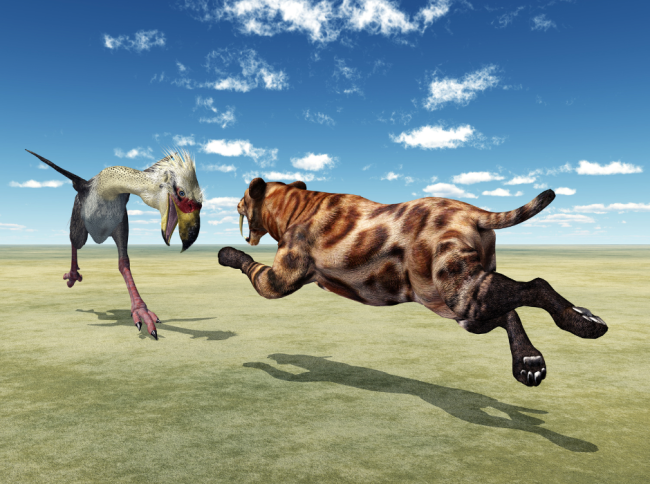
The scientific genus name Phorusrhacos is surely not doing it any justice. That’s why it was nicknamed “the terror bird”.
This huge carnivorous bird used to live during the early Miocene period, in what is today known as South America. Standing at about 2.7 meters tall (8.8 feet), and weighing about 280 lbs or 130 kilograms, it was one of the top predators of its time. It especially loved the woodlands and grasslands of Patagonia, where it would catch its prey with its rudimentary wings shaped like claws that could act as a meat hook. The terror bird would then stab its prey with its terrifying beak and dismember it with its three-toed feet, each toe equipped with a sharp claw.
Virtually any animal smaller than the Phorusrhacos was potential prey, making them real terror birds.
14. Megalania
If the thought of encountering a large lizard in your backyard makes you uneasy, imagine coming face-to-face with Megalania, the largest terrestrial lizard ever known.
It lived during the Pleistocene era in a variety of eastern Australian habitats ranging from open forests to woodlands and grasslands.
If you take a closer look, you might notice a certain resemblance with the Komodo Dragon of Indonesia. However, the Megalania was colossal, reaching up to 5 meters in length. That’s 16 feet. It had a unique crest on its snout, and its teeth were sharp, recurved, and coated with wrinkled, infolded enamel – perfectly made for an exclusive carnivorous diet. Nature always knows.
The Megalania’s skin bore small bones also known as osteoderms, which made it look even more fearsome. Although its evolutionary relationships are not clear, scientists speculate that the Megalania was closer to snakes than other lizard groups. What do you think? Does it look more lizard than snake?
Its diet likely included large prey, like say kangaroos. Scientists found such remains alongside its fossils. As for hunting, the Megalania was quite the strategist. It would ambush its prey using toxic saliva to weaken it before delivering the fatal blow without breaking a sweat.
15. Smilodon
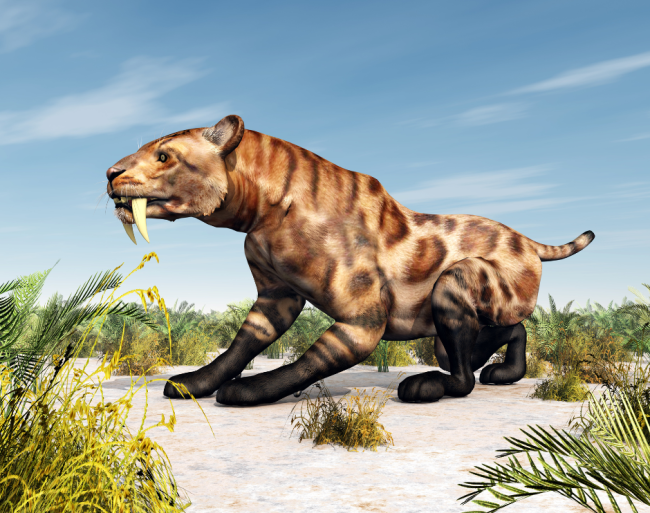
Remember Diego, the grumpy, but friendly and loyal saber-toothed tiger from the Ice Age movies? Well, his real-life counterpart, the Smilodon, might not have been so friendly.
This giant cat, also referred to as the saber-toothed tiger, roamed North and South America during the Pleistocene era. It had elongated dagger-like teeth and a powerful jaw that it used to take down large prey such as bison or even mammoths, earning it a place as one of the most famous extinct mammals ever.
The Smilodon loved habitats that offered a mix of trees and open spaces, perfect for hunting large, slow-moving herbivores. During the hunt, it would use its environment cleverly, stalking its prey through the tall pampas grass or from the trees, relying on short bursts of speed, as their short tails did not provide much balance.
Evidence suggests that Smilodon hunted in groups, much like modern-day lions, and possibly lived in prides, supporting each other when some members were injured or unable to hunt.
Verdict! Scarier than dinosaurs
But let’s talk about the tooth in the room – pun intended. The formidable 8.5-inch long sabres of the Smilodon were actually quite brittle and prone to breaking. So they didn’t really use them to clamp on their prey. They would probably rely more on their powerful forelimbs to wrestle their prey to the ground. Once subdued, another Smilodon from the pack would deliver that fatal bite to the throat.
However, despite their effectiveness as hunters, their long saber teeth prevented them from eating all the parts of their catch, especially the bones. They primarily fed on softer body parts, leaving the rest for scavengers.
Probably the most famous collection of Smilodon fossils comes from the La Brea tar pits in California. Over time, Smilodon spread across the Americas, with lots of subspecies emerging. Despite their success and effectiveness as hunters, they mysteriously went extinct around 10,000 years ago, shortly after humans arrived in the Americans. We might have had something to do with their disappearance, showing once again, the delicate balance in our nature’s ecosystem.
16. Liopleurodon
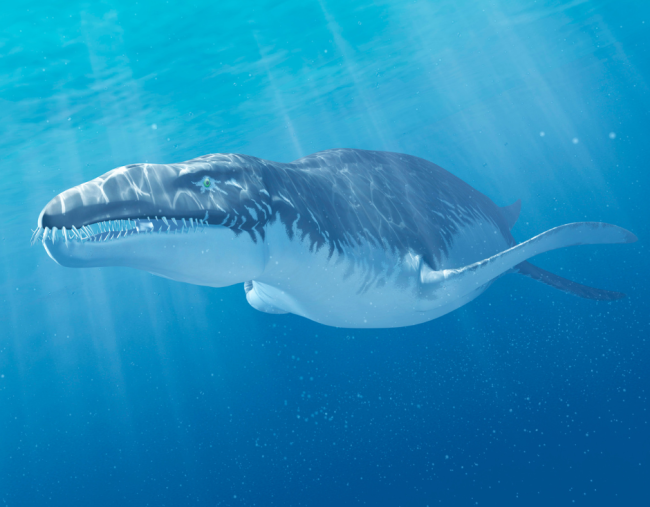
You would believe that the Age of the Dinosaurs was dominated by dinosaurs, but in the depths of the oceans lingered an even more frightening monster – a Liopleurodon.
This marine reptile measured about 82 feet in body length and could move through the waters with a unique grace, propelling itself silently by flapping its gigantic flippers in a swimming style no other creature, past or present, has ever replicated.
Being a reptile meant that the Liopleurodon still needed to breathe air, but even so, it spent its entire life at sea as it was too large and bulky to ever venture on land. Its skull was massive, nearly half the length of its entire body, and it was connected to a relatively short neck. Its jaws were lined with rows of needle-sharp teeth, perfect for preying on any marine creatures in the seas, from crocodiles to sharks, and other pliosaurs. It could even prey on the largest fish known to have ever existed – the 90-foot Leedsichthys.
Unlike other marine reptiles that had to close their nostrils while swimming to avoid drowning, the Liopleurodon had a special type of nose that allowed it to smell underwater, tracking its prey over long distances. Its hunting style would involve lightning-fast bursts of speed with a sudden gulp to swallow its prey whole.
The first Liopleurodon fossils were discovered in France in 1873, with the first specimen measuring about 59 feet. However, more recent findings showed larger 82-feet Liopleurodon with tooth marks that suggested attacks from even larger creatures of its kind.
Scarier than dinosaurs? Absolutely
Overall, the Liopleurodon belonged to a group of short-necked plesiosaurs that shortly became the largest creatures in the oceans during the Early Jurassic. This group also included long-neck plesiosaurs, often thought to be behind the Loch Ness Monster legends.
Although many species of pliosaurs thrived during the Jurassic, ultimately, they were wiped out by the catastrophic events that ended the Cretaceous, 65 million years ago, and then by the arrival of a different kind of predator, a much smaller and less-ferociously looking one, but deadly efficient – the man.
Planet Earth has been around for over 4.5 billion years, but us humans? For 99.998% of our planet’s history, we were nowhere to be found. And yet, we’ve changed our planet so much after we came about. For the worst or for the better? That’s for another article.
